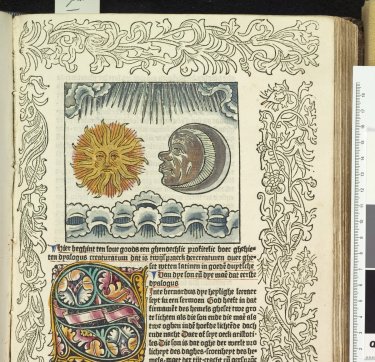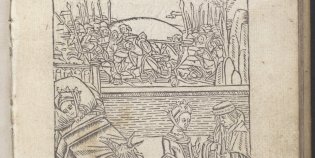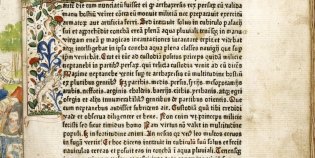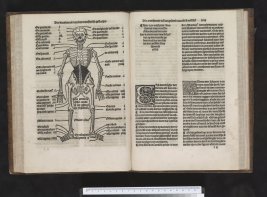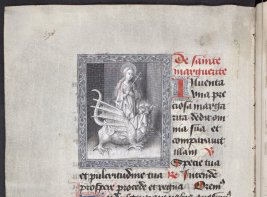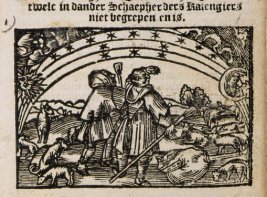Incunabula
Overview of the incunabula collection
- Contents: collection of printed works from the 15th century, printed in the Netherlands or elsewhere in Europe.
- Size: approximately 2.200 incunabula, 900 of which were printed in the Netherlands.
- Access: can be found in the KB catalogue. Cannot be lent out but are available for inspection in the Special Collections reading room.
- More information: Esther van Gelder.
What are incunabula?
Book printing emerged in Europe during the mid-15th century. For the first time, books were printed with a printing press and movable type made of lead. This enabled writers and publishers to copy texts much faster than by hand. The very first books printed using this technique (until 1 January 1501) are called incunabula. The making of these books involved a lot of experimentation with design, images and fonts, which means that incunabula tell a lot about the revolution this new medium caused in the 15th century. It allowed news to be disseminated faster and reach a wider audience.
Contents of the incunabula collection
The KB has the world’s largest collection of incunabula from the Low Countries. Some 2.200 different books were printed here in the 15th century, of which over 900 can be found in the KB. The KB also has around 1.300 incunabula from other European countries. The main locations include Cologne (360 editions), Venice (181), Strasbourg (114), Paris (88), Basel (65) and Nuremberg (56).
History of the incunabula collection
When the KB was founded in 1798, the collection contained only a few incunabula, which came from the stadtholder's library. The collection was added to in 1807, mainly with foreign prints by jurist and political administrator Joost Romswinckel (1745-1824). In 1809, the KB acquired 400 copies from the collection of Jacob Visser (1724-1804). Visser had assembled the collection to create the first bibliography of incunabula printed in the Low Countries.
The collection of printed works from Tongerlo Abbey was another important addition in 1828. With this, the KB acquired 70 incunabula, including the block book Biblia pauperum (1460-1470). The collection was also expanded in the 19th century with 125 incunabula found in an attic in Maastricht in 1840. The same thing happened with 50 books found in a cupboard in the rectory in Weesp in 1847. The collection is still expanding.
Accessibility of the incunabula collection
The incunabula are described in the KB catalogue. This also includes information about previous owners and how the books arrived in the KB collection. If a book has been digitised, you will also find links to the online copy in Google Books or Early European Books. You can view incunabula in the Special Collections reading room. They can also be found in major national and international bibliographies:
- Incunabula Short-Title Catalogue (ISTC), a British Library database containing nearly 30.000 descriptions of all incunabula around the world. It also contains information on Dutch incunabula.
- Gesamtkatalog der Wiegendrucke (GW), an online follow-up to the eponymous printed bibliography, in which all incunabula worldwide are described in detail.
- Short-Title Catalogue, Netherlands (STCN), the online bibliography of all books printed in the Netherlands prior to 1801. It describes the basic details of the incunabula.
KB curators and researchers studied the incunabula in detail. See the bibliography for key catalogues.
Dating incunabula using watermarks
We do not know exactly how old many of the incunabula are. It is also often unknown who printed them. Researchers can find out by studying the fonts and the watermarks in the paper, which is why the KB examined the paper of some 2.200 Dutch incunabula. This yielded more than 17.000 images of watermarks. These are organised by book, printer and presentation in the Watermarks in Incunabula printed in the Low Countries (WILC) database. The website has a detailed introduction to the research. The data from WILC can also be accessed in Memory of Paper, along with other European watermarking databases.
Literature about the Incunabula collection
Books
- Holtrop, J.W. Catalogus librorum saeculo XV° impressorum, quotquot in Bibliotheca Regia Hagana asservantur. Nijhoff, 1856.
- Campbell, M.F.A.G. Annales de la typographie Neerlandaise au XVe siecle. Nijhoff, 1874.
- Hellinga, W. & Hellinga, L. The Fifteenth-Century Printing Types of the Low Countries. Menno Hertzberger, 1966.
- Thienen, G. van (red.). Incunabula in Dutch Libraries: A Census of Fifteenth-century Printed Books in Dutch Public Collections. De Graaf, 1983.
- Thienen, G. van & Goldfinch, J. (red.). Incunabula Printed in the Low Countries, a Census. De Graaf, 1999.
- Kok, I. Woodcuts in Incunabula Printed in the Low Countries. Hes & De Graaf, 2013.
- Rückert, R., Hodocek, S. & Wenger, E. (red.). Bull's Head and Mermaid. The History of Paper and Watermarks from the Middle Ages to the Modern Period.Landesarchiv Baden-Württemberg/Austrian Academy of Sciences, 2009.
